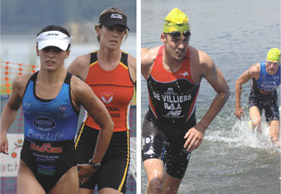So you have finished a road race or two, maybe the Comrades or Two Oceans, done the 94.7 Cycle Challenge and want a new challenge.
Then TRIATHLON is for you!
Triathlon is one of the fastest growing sports in the world.
WHY TRI?
As most runners can confirm, training only for running races places a big strain on our bodies, especially as we get older. By doing triathlon, or any other similar multi-sport event, you can still maintain a very good level of fitness and enjoyment that comes with training for other disciplines. In fact, you may even become a better all-round athlete in the process. You will certainly experience fewer injuries than someone who only runs.
So what is triathlon and HOW DO I START?
Triathlon is an event that requires you to swim, cycle and run in that order. The distance can vary from the easily achievable sprint right up to the Iron Man, which is a major achievement. To get started, you need to commit yourself to an event. Do not go big and decide on the Iron Man;
set yourself a simple but achievable goal, such as completing one of the summer Energade Sprint races that start in October, and take it from there. These events consist of a 600m swim, 20km bike ride and a 5km run.
How do I train for three events and how do I split my time accordingly?
As a novice this is very simple. Aim to train six days of the week with one rest day. Swim twice, run twice, cycle twice – easy. Focus on a different discipline each day. Initially keep the training very simple. You are trying to build a triathlon base and will need to get used to doing three sports. Try to stick to the schedule below.
RUN – 8/10km twice a week. Try and do this with a running club.
BIKE – Cycle the roads or do spinning classes twice a week for 45 minutes to an hour. Try to do one outdoor ride on the weekend.
SWIM – Get into a heated pool at your local gym and swim for 20 to 30 minutes.
For most novice triathletes, the swim is the most daunting. So start simply; try to swim for 4/6 lengths non-stop. Then rest and repeat for 20 to 30 minutes. Get the local swim coach to give you tips on your stroke or ask fellow triathletes/swimmers for advice.
Follow this type of training until you feel comfortable doing the three disciplines each week. Don’t worry if you miss a session. Continue this training for at least two to three months, aiming at three sessions per discipline with a minimum of one session per discipline per week. Once you are comfortable with this, you can try to increase to three sessions per discipline per week, which will mean training twice a day on some days.
When I started doing triathlons in 2000, I aimed to do four times the race distance in training each week. This is a formula that worked for me, and it can certainly work for you. For the Energade sprint races, this will mean about 2.5km of swimming, 80km of cycling and 20km of running. This cumulates to a total training time of about six to seven hours (one hour a day) which most road runners can do easily. However, you do not have the cumulative effect on the body, of only focusing on one sport, so you get fit with less risk of injury.
If you aim to do a Standard Olympic event (1.5km swim/40km cycle/10km run), using the same formula will mean about 12 hours of training a week, but you can get away with a lot less if your aim is simply to finish the event.
It may sometimes be better to find something in between that suits your ability, goals and family/work time constraints. Remember, in the beginning you need to just go out and swim, cycle and run. Don’t worry about pace or what type of training you are doing, just tick off the six sessions a week.
What equipment do you need to start?
Again, keep it simple. It is easy to get caught up in the techno hype of buying the latest equipment. For running, stick to shoes, shorts and the usual t-shirt. For cycling, use either a road or mountain bike, helmet, cycling shorts and proper cycling shoes. For swimming, only a costume or Speedo will do. Yes guys, you need to swim in a Speedo not baggies. Also get yourself some decent goggles and a cap.
Remember, KEEP IT SIMPLE to start with. Now get out there and enjoy your new challenge.
In future articles, we will cover what type of training is ideal, including sample swim sessions, as well as tips for your first triathlon.
See you on the road – in the saddle – or in the pool.


